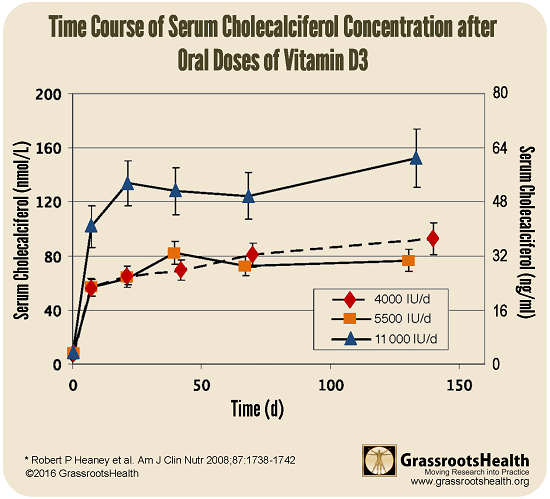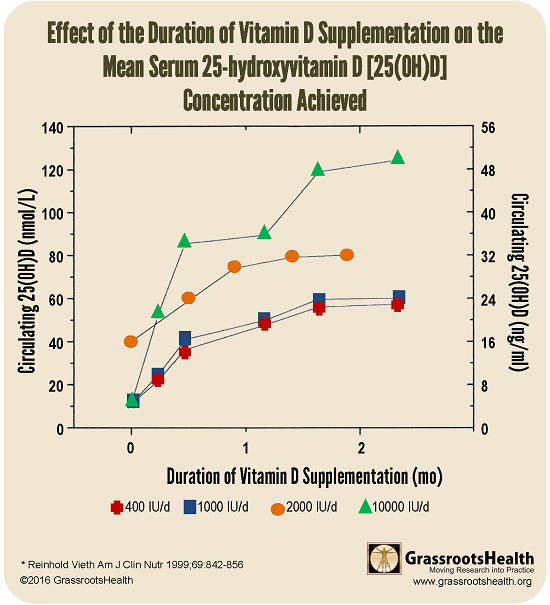Published on September 18, 2018
 Participants often ask about details on how and when to change their vitamin D supplementation based on their vitamin D test results. “How much vitamin D should I take with a level of XX?”, “When should I test again to see if my new intake has increased my level enough?”, and “Should I wait to test until after I have changed my supplement intake?” are questions we frequently receive.
Participants often ask about details on how and when to change their vitamin D supplementation based on their vitamin D test results. “How much vitamin D should I take with a level of XX?”, “When should I test again to see if my new intake has increased my level enough?”, and “Should I wait to test until after I have changed my supplement intake?” are questions we frequently receive.
How much to take?
Using the data from our study, GrassrootsHealth has developed an online vitamin D calculator to help you determine how much vitamin D intake may be needed to go from a baseline vitamin D level to a target vitamin D level. Simply input your weight with your current vitamin D test result, current supplemental intake, and your target vitamin D level, and it will calculate the estimated total Vitamin D intake needed to reach your target vitamin D level. Two values will be given – one that has been shown effective for the average participant, and one that has been shown to be effective for 90% of the GrassrootsHealth population.
Change in Vitamin D3 Levels
When attempting to adjust your vitamin D level through a change in vitamin D supplementation, the time to wait between the initial test and the re-test is another important factor to consider. If testing is done too soon after the change in supplementation, it could reflect a serum level that is still in flux (and lower than would be expected), giving a false reading of how an individual is actually responding to that new dose.
As we consider how to change our vitamin D levels, it is useful to know first how the concentration of vitamin D3 (the actual form of vitamin D taken from supplements), changes. Vitamin D3 is converted in the body to 25(OH) vitamin D, the form of vitamin D that is measured with your GrassrootsHealth vitamin D test, and has a much shorter half-life than 25(OH) vitamin D – meaning it gets used up much more quickly (more in the Bolus Dosing section below).
In an analysis by Heaney et al., the following chart shows that in response to daily supplementation (4000, 5500, or 11,000 IU/day), serum vitamin D3 increased rapidly during the first week, then declined and plateaued around 3 weeks, with continued variation until about day 60 (2 months).

Resulting 25(OH) Vitamin D Levels
What about changes in the 25(OH) vitamin D level? In a paper published by Reinhold Vieth, the mean 25(OH) vitamin D levels of four separate groups of individuals, supplementing at different daily doses of vitamin D (400 IU, 1000 IU, 2000 IU and 10,000 IU) and tracked over the span of 2-3 months, were reported. Serum levels of 25(OH)D rose at a much higher rate during the first month of supplementation, and continued to rise at a slower pace over the following month. Levels reached a plateau by 2 months for the 400, 1000 and 2000 IU/d groups, while the 10,000 IU/d group continued to experience a slight increase.

What about Bolus Dosing?
New concepts about the way the body utilizes vitamin D beyond its well-established endocrine functions for bone health, have shed light on the importance of obtaining a daily dose of vitamin D3, versus bolus doses (larger doses at weekly, monthly, or longer intervals). Vitamin D3 is a relatively short-lived compound in the body with a half-life of less than 24 hours, making serum D3 an unreliable marker for an individual’s vitamin D status. The short half-life also means that dosing intervals of a week or greater can lead to depletion of vitamin D3 in the serum altogether.
How quickly do serum levels of vitamin D3 and 25(OH) vitamin D respond to a single high dose of vitamin D3?
As illustrated in the following chart by Heaney et al., after a single dose of 100,000 IU D3, vitamin D3 increased sharply and returned to its initial low state within 2 weeks. The corresponding 25(OH) vitamin D levels rose and fell at a much slower rate. It took approximately 1 week for the 25(OH) D serum level to reach its max, and levels slowly declined over the next 2-3 months.

GrassrootsHealth scientists have agreed that daily dosing of vitamin D3 is preferred over bolus dosing (such as bi-weekly, monthly, or yearly). Daily dosing results in a fairly steady level of serum D3 with little fluctuation and risk for depletion, whereas weekly dosing (taking a single dose at 7 times the daily dose, once per week) causes a spike in vitamin D3 level, which then quickly drops and leaves the blood depleted of vitamin D3.
What does this all mean?
Once a new dose of vitamin D supplementation has been determined and incorporated into the daily routine, in order to get an accurate representation of the resulting 25(OH) vitamin D serum level, it is recommended that you wait at least 2-3 months before testing again. This will allow the resulting 25(OH) vitamin D serum level enough time to adjust to the new dose and reach its plateau.
